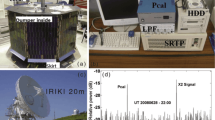Abstract
The Miniature Radio Frequency (Mini-RF) system is manifested on the Lunar Reconnaissance Orbiter (LRO) as a technology demonstration and an extended mission science instrument. Mini-RF represents a significant step forward in spaceborne RF technology and architecture. It combines synthetic aperture radar (SAR) at two wavelengths (S-band and X-band) and two resolutions (150 m and 30 m) with interferometric and communications functionality in one lightweight (16 kg) package. Previous radar observations (Earth-based, and one bistatic data set from Clementine) of the permanently shadowed regions of the lunar poles seem to indicate areas of high circular polarization ratio (CPR) consistent with volume scattering from volatile deposits (e.g. water ice) buried at shallow (0.1–1 m) depth, but only at unfavorable viewing geometries, and with inconclusive results. The LRO Mini-RF utilizes new wideband hybrid polarization architecture to measure the Stokes parameters of the reflected signal. These data will help to differentiate “true” volumetric ice reflections from “false” returns due to angular surface regolith. Additional lunar science investigations (e.g. pyroclastic deposit characterization) will also be attempted during the LRO extended mission. LRO’s lunar operations will be contemporaneous with India’s Chandrayaan-1, which carries the Forerunner Mini-SAR (S-band wavelength and 150-m resolution), and bistatic radar (S-Band) measurements may be possible. On orbit calibration, procedures for LRO Mini-RF have been validated using Chandrayaan 1 and ground-based facilities (Arecibo and Greenbank Radio Observatories).
Similar content being viewed by others
References
J.R. Arnold, Ice in the lunar polar regions. J. Geophys. Res. 84, 5659–5668 (1979)
B. Butler, The migration of volatiles on the surfaces of Mercury and the Moon. J. Geophys. Res. 102, 19,283–19,291 (1997)
D.B. Campbell, B.A. Campbell, L.M. Carter, J.-L. Margot, N.J.S. Stacy, No evidence for thick deposits of ice at the lunar South Pole. Nature 443, 835–837 (2006)
R.C. Elphic, V.R. Eke, L. Teodoro, D.J. Lawrence, D.B.J. Bussey, Models of the distribution and abundance of hydrogen at the lunar South Pole. Geophys. Res. Lett. 34, L13204 (2007). doi:10.1029/2007GL029954
W.C. Feldman, S. Maurice, A.B. Binder, B.L. Barraclough, R.C. Elphic, D.J. Lawrence, Fluxes of fast and epithermal neutrons from lunar prospector: evidence for water ice at the lunar poles. Science 281, 1496–1500 (1998)
W.C. Feldman, D.J. Lawrence, R.C. Elphic, B.L. Barraclough, S. Maurice, I. Genetay, A.B. Binder, Polar hydrogen deposits on the Moon. J. Geophys. Res. 105(E2), 4175–4195 (2000)
J.K. Harmon, M.A. Slade, Radar mapping of Mercury: Full-disk Doppler delay images. Science 258, 640–643 (1992)
M.I. Mishchenko, Polarization characteristics of the coherent backscatter opposition effect. Earth Moon Planets 58, 127–144 (1992)
H. Noda, H. Araki, S. Goossens, Y. Isihara, K. Matsumoto, S. Tazawa, S. Sasaki, N. Kawano, S. Sasaki, Illumination conditions at the lunar polar regions by Kaguya (SELENE) laser altimeter. Geophys. Res. Lett. 35, L24203 (2008). doi:10.1029/2008GL035692
S. Nozette, C. Lichtenberg, P.D. Spudis, R. Bonner, W. Ort, E. Malaret, M. Robinson, E.M. Shoemaker, The Clementine bistatic radar experiment. Science 274, 1495–1498 (1996)
S. Nozette, E.M. Shoemaker, P.D. Spudis, C.L. Lichtenberg, The possibility of ice on the Moon. Science 278, 144–145 (1997)
S. Nozette, P.D. Spudis, M. Robinson, D.B.J. Bussey, C. Lichtenberg, R. Bonner, Integration of lunar polar remote-sensing data sets: Evidence for ice at the lunar South Pole. J. Geophys. Res. 106(E19), 23253–23266 (2001)
R.K. Raney, Hybrid-polarity SAR architecture. IEEE Trans. Geosci. Remote Sens. 45, 3397–3404 (2007)
R.A. Simpson, G.L. Tyler, Reanalysis of Clementine bistatic radar data for the lunar South Pole. J. Geophys. Res. 104, 3845–3862 (1999)
P.D. Spudis, Ice on the Moon. Space Rev. (2006). http://www.thespacereview.com/article/740/1
P. Spudis, S. Nozette, B. Bussey, K. Raney, H. Winters, C.L. Lichtenberg, W.M. Marinelli, J.C. Crusan, M.M. Gates, Mini-SAR: An imaging radar experiment for the Chandrayaan-1 mission to the Moon. Curr. Sci. (India) 96, 533–539 (2009)
N.J.S. Stacy, High-resolution synthetic aperture radar observations of the moon. Ph.D. dissertation, Cornell University, Ithaca, NY (1993)
N.J.S. Stacy, D.B. Campbell, P.G. Ford, Arecibo radar mapping of the lunar poles: A search for ice deposits. Science 276, 1527–1530 (1997)
Author information
Authors and Affiliations
Corresponding author
Rights and permissions
About this article
Cite this article
Nozette, S., Spudis, P., Bussey, B. et al. The Lunar Reconnaissance Orbiter Miniature Radio Frequency (Mini-RF) Technology Demonstration. Space Sci Rev 150, 285–302 (2010). https://doi.org/10.1007/s11214-009-9607-5
Received:
Accepted:
Published:
Issue Date:
DOI: https://doi.org/10.1007/s11214-009-9607-5




